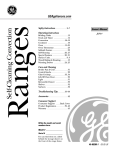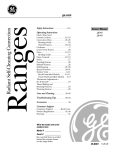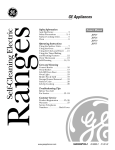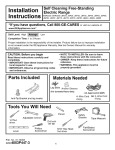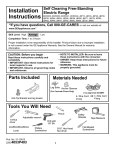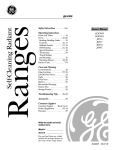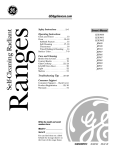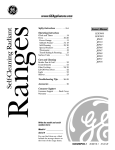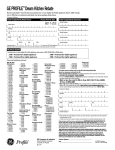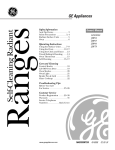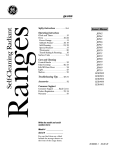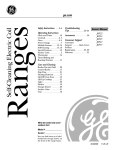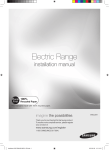Download GE JBP66 Electric Kitchen Range
Transcript
Installation Instructions Free-Standing Electric Ranges Questions? Call 800.GE.CARES (800.432.2737) or Visit our Website at: www.GEAppliances.com EER3000, EER3001, JBP24, JBP25, JBP26, JBP35, JBP48, JBP64, JBP66, JBP67, JBP68, JBP69, JBP71, JBP78, JBP80, JBP82, JBP83, JBP84, JBP99, JB600, JB710, JB905, JB968, JB988, JBS55 BEFORE YOU BEGIN ANTI-TIP DEVICE Read these instructions completely and carefully. • IMPORTANT • IMPORTANT • • • • • • WARNING — To reduce the risk of tipping, the appliance must be secured by properly installed Anti-Tip bracket packed with this appliance. If the Anti-Tip device supplied with the range does not fit this application, use the universal Anti-Tip device WB2X7909. — Save these instructions for local inspector’s use. — Observe all governing codes and ordinances. Note to Installer – Be sure to leave these instructions with the Consumer. Note to Consumer – Keep these instructions for future reference. Skill level – Installation of this appliance requires basic mechanical skills. Completion time – 1 to 3 hours Proper installation is the responsibility of the installer. Product failure due to improper installation is not covered under the Warranty. WARNING — • All ranges can tip • Injury to persons could result • Install Anti-Tip bracket packed with range • See Installation Instructions If you pull the range out and away from the wall for any reason, make sure the Anti-Tip bracket is engaged when the range is pushed back against the wall. WARNING — This appliance must be properly grounded. FOR YOUR SAFETY: WARNING — Before beginning the installation, switch power off at service panel and lock the service disconnecting means to prevent power from being switched on accidentally. When the service disconnecting means cannot be locked, securely fasten a prominent warning device, such as a tag, to the service panel. 229C4053P545-5 31-10556-5 06-04 JR 1 Installation Instructions PREPARE TO INSTALL THE RANGE FOR YOUR SAFETY: MATERIALS YOU MAY NEED All rough-in and spacing dimensions must be met for safe use of your range. Electricity to the range can be disconnected at the outlet without moving the range if the outlet is in the preferred location (remove lower drawer). Tin Snips Lag Bolts Anchor Sleeves (For Anti-Tip Bracket Mounted on Concrete Floors Only) To reduce the risk of burns or fire when reaching over hot surface elements, cabinet storage space above the cooktop should be avoided. If cabinet storage space is to be provided above the cooktop, the risk can be reduced by installing a range hood that sticks out at least 5” beyond the front of the cabinets. Cabinets installed above a cooktop must be no deeper than 13” . (UL Approved 40 AMP) 4-Wire Cord OR 3-Wire Cord 4‘ Long 4‘ Long Be sure your appliance is properly installed and grounded by a qualified technician. Squeeze Connector (For Conduit Installations Only) PARTS INCLUDED Make sure the cabinets and wall coverings around the range can withstand the temperatures (up to 200°F.) generated by the range. Anti-Tip Bracket Kit TOOLS YOU WILL NEED 1 REMOVE SHIPPING MATERIALS Drill with 1/8” Bit Remove packaging materials. Failure to remove packaging materials could result in damage to the appliance. Safety Glasses Adjustable Wrench Tape Measure Pliers Pencil 1/4” Nut Driver Level Phillips Screwdriver Flat-blade Screwdriver 2 Installation Instructions 2 PREPARE THE OPENING See illustrations for all rough-in and spacing dimensions. The range may be placed with 0” clearance (flush) at the back wall and side walls of the cabinet. Acceptable electrical outlet area. Orient the electrical receptacle so the length is parallel to the floor. **30” Min. ***6” Min. **15” Min. 21⁄2” 25” 21⁄2” *0” MINIMUM DIMENSIONS BETWEEN COOKTOP, WALLS AND ABOVE THE COOKTOP: 71⁄2” 36” *0” *** Make sure the wall covering, countertop and cabinets around the range can withstand the heat (up to 200°F) generated by the range. 30” *** Allow 30” minimum clearance between surface units and bottom of unprotected wood or metal cabinet, and 15” minimum between countertop and adjacent cabinet bottom. NOTE: Use a 4′ power cord to prevent interference with the storage drawer. Power cords 41⁄2 to 6′ long may have to be dressed to allow for proper drawer closing. *** Recommended spacing to heat-sensitive surfaces. 3 Installation Instructions ELECTRICAL CONNECTIONS ELECTRICAL REQUIREMENTS Use only a 3-conductor or a 4-conductor UL-listed range cord. These cords may be provided with ring terminals on wire and a strain relief device. CAUTION: For personal safety, do not use an extension cord with this appliance. Remove house fuse or open circuit breaker before beginning installation. A range cord rated at 40 amps with 125/250 minimum volt range is required. A 50 amp range cord is not recommended but if used, it should be marked for use with nominal 13⁄8″ diameter connection openings. Care should be taken to center the cable and strain relief within the knockout hole to keep the edge from damaging the cable. This appliance must be supplied with the proper voltage and frequency, and connected to an individual properly grounded branch circuit, protected by a circuit breaker or fuse having amperage as specified on the rating plate. The rating plate is located above the storage drawer on the oven frame. • Because range terminals are not accessible after range is in position, flexible service conduit or cord must be used. We recommend you have the electrical wiring and hookup of your range connected by a qualified electrician. After installation, have the electrician show you where your main range disconnect is located. NOTE: If conduit is being used, go to Step 3D and then to Step 6 or 7. • On some models, a filter capacitor may be connected between the black and white leads on the junction block. Check with your local utilities for electrical codes which apply in your area. Failure to wire your oven according to governing codes could result in a hazardous condition. If there are no local codes, your range must be wired and fused to meet the requirements of the National Electrical Code, ANSI/NFPA No. 70– Latest Edition. You can get a copy by writing: ALL NEW CONSTRUCTIONS, MOBILE HOMES AND INSTALLATIONS WHERE LOCAL CODES DO NOT ALLOW GROUNDING THROUGH NEUTRAL, REQUIRE A 4-CONDUCTOR UL-LISTED RANGE CORD. National Fire Protection Association Batterymarch Park Quincy, MA 02269 Effective January 1, 1996, the National Electrical Code requires that new construction (not existing) utilize a 4-conductor connection to an electric range. When installing an electric range in new construction, follow Steps 3 and 5 for 4-wire connection. You must use a 3-wire, single-phase A.C. 208Y/120 Volt or 240/120 Volt, 60 hertz electrical system. If the electrical service provided does not meet the above specifications, have a licensed electrician install an approved outlet. 4 Installation Instructions 3 POWER CORD AND STRAIN RELIEF INSTALLATION A C Remove the wire cover (on the back of the range) by removing five (5) screws using a 1/4” nut driver. Do not discard these screws. 5 screws to remove wire cover For power cord installations only (see the next step if using conduit), assemble the strain relief in the hole. Insert the power cord through the strain relief and tighten. Allow enough slack to easily attach the cord terminals to the terminal block. If tabs are present at the end of the winged strain relief, they can be removed for better fit. NOTE: Do not install the power cord without a strain relief. The strain relief bracket should be installed before reinstalling the rear range wiring cover. Terminal block Retaining tabs Strain relief Back of range Wire cover B Power cord Remove the knockout ring (13⁄8″) located on bracket directly below the terminal block. To remove the knockout, use a pair of pliers to bend the knockout ring away from the bracket and twist until ring is removed. Bracket Skip to Step 4 or 5. D Terminal block (appearance may vary) For conduit installations only, purchase a squeeze connector matching the diameter of your conduit and assemble it in the hole. Insert the conduit through the squeeze connector and tighten. Allow enough slack to easily attach the wires to the terminal block. NOTE: Do not install the conduit without a squeeze connector. The squeeze connector should be installed before reinstalling the rear range wiring cover. Terminal block Knockout ring in bracket Knockout ring removed Squeeze connector Conduit 5 Skip to Step 6 or 7. Bracket Installation Instructions ELECTRICAL CONNECTIONS 4 3-WIRE POWER CORD INSTALLATION (CONT.) 5 4-WIRE POWER CORD INSTALLATION WARNING: WARNING: The neutral or ground wire of the power cord must be connected to the neutral terminal located in the center of the terminal block. The power leads must be connected to the lower left and the lower right terminals of the terminal block. A The neutral wire of the supply circuit must be connected to the neutral terminal located in the lower center of the terminal block. The power leads must be connected to the lower left and the lower right terminals of the terminal block. The 4th grounding lead must be connected to the frame of the range with the ground plate and the ground screw. Remove the 3 lower terminal screws from the terminal block. Insert the 3 terminal screws through each power cord terminal ring and into the lower terminals of the terminal block. Be certain that the center wire (white/neutral) is connected to the center lower position of the terminal block. Tighten screws securely into the terminal block. DO NOT remove the ground strap connection. A B C D Terminal block (appearance may vary) Neutral terminal Remove the 3 lower terminal screws from the terminal block. Remove the ground screw and ground plate and retain them. Cut and discard the ground strap. DO NOT DISCARD ANY SCREWS. Insert the one ground screw into the power cord ground wire terminal ring, through the ground plate and into the frame of the range. Insert the 3 terminal screws (removed earlier) through each power cord terminal ring and into the lower terminals of the terminal block. Be certain that the center wire (white/neutral) is connected to the center lower position of the terminal block. Tighten screws securely into the terminal block. Ground strap Before Ground plate Terminal block Ground strap Ground strap or Neutral terminal After Neutral terminal Terminal block Power cord B Skip to Step 8 and proceed with the installation. Ground plate (grounding to range) Ground screw E 6 Skip to Step 8 and proceed with the installation. Installation Instructions 6 3-WIRE CONDUIT INSTALLATION A 7 4-WIRE CONDUIT INSTALLATION Loosen the 3 lower terminal screws from the terminal block. Insert the center bare wire (white/neutral) tip through the bottom center terminal block opening. On certain models, the wire will need to be inserted through the ground strap opening and then into the bottom center block opening. Insert the two side bare wire tips into the lower left and the lower right terminal block openings. Tighten the screws until the wire is firmly secured (35 to 50 inch-lbs.). Do not over-tighten the screws since it could damage the wires. A B NOTE: ALUMINUM WIRING: Aluminum building wire may be used but it must be rated for the correct amperage and voltage to make connection. Connect wires according to this Step 6 or Step 7 depending on number of wires. Loosen the three lower terminal screws from the terminal block. Remove the ground screw and ground plate and retain them. Cut and discard the ground strap. DO NOT DISCARD ANY SCREWS. Insert the ground bare wire tip between the range frame and the ground plate (removed earlier) and secure it in place with the ground screw (removed earlier). Insert the bare wire (white/neutral) tip through the bottom center of the terminal block opening. Insert the two side bare wire tips into the lower left and the lower right terminal block openings. Tighten the screws until the wire is firmly secured (35 to 50 inch-lbs.). Do not over-tighten the screws since it could damage the wires. Before Ground strap Terminal block Ground strap Terminal block or Neutral terminal After Wire tips Terminal block Wire tips Bracket Conduit Ground screw Wire used, location and enclosure of splices, etc., must conform to good wiring practices and local codes. B Ground plate (grounding to range) Bracket Skip to Step 8 and proceed with the installation. Wire used, location and enclosure of splices, etc., must conform to good wiring practices and local codes. C 7 Proceed to Step 8. Installation Instructions INSTALL THE RANGE 8 REPLACE THE WIRE COVER 10 REMOVE STORAGE DRAWER Replace the wire cover on the range back by sliding its left edge under the retaining tabs and replacing the five screws removed earlier. Make sure that no wires are pinched between the cover and the range back. A Pull the drawer out until it stops. B Lift the front of the drawer until the stops clear the guide. 5 screws to replace wire cover Stop Retaining tabs C Back of range Wire cover 9 ANTI-TIP DEVICE INSTALLATION An Anti-Tip bracket is supplied with instructions for installation in a variety of locations. The instructions include all necessary information to complete the installation. Read the Safety Instructions and the instructions that fit your situation before beginning installation. Bracket Wall plate Screw must enter wood or metal Typical installation of anti-tip bracket attachment to wall WARNING: • Range must be secured by Anti-Tip bracket supplied. • If the Anti-Tip device supplied with the range does not fit this application, use the universal Anti-Tip device WB2X7909. • See instructions to install (supplied with bracket). • Unless properly installed, the range could be tipped by stepping or sitting on the door. Injury may result from spilled hot liquids or from the range itself. 8 Remove the drawer. Installation Instructions 11 LEVEL THE RANGE A B C 13 FINAL INSTALLATION CHECKLIST Install the oven shelves in the oven and position the range where it will be installed. Check for levelness by placing a spirit level or Spirit level a cup, partially filled with water, on one of the oven shelves. If using a spirit level, take two readings—with the level placed diagonally first in one direction and then the other. The front leveling legs can be adjusted from the bottom and the rear legs can be adjusted from the top or the bottom. • Check to make sure the circuit breaker is closed (RESET) or the circuit fuses are replaced. • Be sure power is in service to the building. • Check to be sure that all packing materials and tape have been removed. This will include tape on metal panel under control knobs (if applicable), adhesive tape, wire ties, cardboard and protective plastic. Failure to remove these materials could result in damage to the appliance once the appliance has been turned on and surfaces have heated. • Check to make sure that the door and drawer are parallel to each other and that both operate smoothly. If they do not, see the Owner’s Manual for proper replacement. Lower range Leg leveler • Check to make sure that the rear leveling leg is fully inserted into the Anti-Tip bracket and that the bracket is securely installed. Raise range D Use an open-end or adjustable wrench to adjust the leveling legs until the range is level. 14 OPERATION CHECKLIST • Turn on one of the surface units to observe that the element glows within 60 seconds. Turn the unit off when glow is detected. If the glow is not detected within the time limit, recheck the range wiring connections. If change is required, retest again. If no change is required, have building wiring checked for proper connections and voltage. 12 REPLACE THE STORAGE DRAWER A Place the drawer rail on the guides. B Push the drawer in until it stops. C Lift the front of the drawer and push in until the stops clear the guides. • Check to make sure the Clock (on models so equipped) display is energized. If a series of horizontal red lines appear in the display, disconnect power immediately. Recheck the range wiring connections. If change is made to connections, retest again. If no change is required, have building wiring checked for proper connections and voltage. It is recommended that the clock be changed if the red lines appear. D Lower the front of the drawer and push in until it closes. • Be sure all range controls are in the OFF position before leaving the range. Stop 9 Notes 10 Notes 11 12 Printed in the United States












